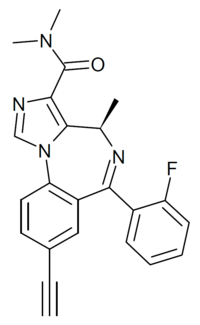From Wikipedia, the free encyclopedia
GL-II-73
(4R)-8-ethynyl-6-(2-fluorophenyl)-N,N,4-trimethyl-4H-benzo[f]imidazo[1,5-a] [1,4]diazepine-3-carboxamide
PubChem CID Formula C 23 H 19 F N 4 O Molar mass −1 3D model (JSmol )
CN(C)C(=O)c4ncn2c4[C@@H](C)N=C(c1cc(C#C)ccc12)c3ccccc3F
InChI=1S/C23H19FN4O/c1-5-15-10-11-19-17(12-15)20(16-8-6-7-9-18(16)24)26-14(2)22-21(23(29)27(3)4)25-13-28(19)22/h1,6-14H,2-4H3/t14-/m1/s1
Key:LNPOWXXHIUMIKI-CQSZACIVSA-N
GL-II-73 (GL-ii-073 ) is a benzodiazepine derivative related in chemical structure to compounds such as midazolam , adinazolam and the active metabolite of rilmazafone . It is described as an α5 preferring positive allosteric modulator of the benzodiazepine site of GABAA receptors , with weaker activity at α2 and α3 and no significant affinity for the α1 subtype. In animal tests it was found to produce effects consistent with antidepressant , anxiolytic and nootropic actions.[1] [2] [3] [4]
See also [ ] References [ ]
^ CA 3016491 , Cook JM, Li G, Poe M, Savic M, Sibille E, "Treatment of cognitive and mood symptoms in neurodegenerative and neuropsychiatric disorders with alpha5-containing gabaa receptor agonists.", published 21 September 2017, assigned to Centre for Addiction and Mental Health, Faculty Of Pharmacy, University of Belgrade and UWM Res Foundation Inc ^ Prevot TD, Li G, Vidojevic A, Misquitta KA, Fee C, Santrac A, et al. (January 2018). "Potential combined pro-cognitive, anxiolytic and antidepressant properties of novel GABAA receptor positive modulators with preferential efficacy at the α5-subunit" (PDF) . bioRxiv : 332908. doi :10.1101/332908 . S2CID 90987308 . ^ Prevot TD, Li G, Vidojevic A, Misquitta KA, Fee C, Santrac A, Knutson DE, Stephen MR, Kodali R, Zahn NM, Arnold LA, Scholze P, Fisher JL, Marković BD, Banasr M, Cook JM, Savic M, Sibille E (April 2019). "Novel Benzodiazepine-Like Ligands with Various Anxiolytic, Antidepressant, or Pro-Cognitive Profiles" . Molecular Neuropsychiatry . 5 (2): 84–97. doi :10.1159/000496086 . PMC 6528097 PMID 31192221 . ^ Sibille E (February 2019). "Brain Inhibitory GABAergic Function and Cognitive Deficits: Mechanisms and Therapeutic Targeting" (PDF) . Presentation for AAAS .
Benzodiazepines
1,4-Benzodiazepines 1,5-Benzodiazepines 2,3-Benzodiazepines* Triazolobenzodiazepines Imidazobenzodiazepines
Bretazenil Climazolam EVT-201 FG-8205 Flumazenil GL-II-73 Imidazenil 123 I-IomazenilL-655,708 Loprazolam Midazolam PWZ-029 Remimazolam Ro15-4513 Ro48-6791 Ro48-8684 Ro4938581 Sarmazenil SH-053-R-CH3-2′F Oxazolobenzodiazepines Thienodiazepines Thienotriazolodiazepines Thienobenzodiazepines *Pyridodiazepines Pyridotriazolodiazepines Pyrazolodiazepines Pyrrolodiazepines Tetrahydroisoquinobenzodiazepines Pyrrolobenzodiazepines *Benzodiazepine prodrugs * atypical activity profile (not GABAA receptor ligands)
GABA A receptor positive modulatorsAlcohols
Butanol Chloralodol Chlorobutanol (cloretone) Ethanol (alcohol) (alcoholic drink )Ethchlorvynol Isobutanol Isopropanol Menthol Methanol Methylpentynol Pentanol Petrichloral Propanol tert -Butanol (2M2P)tert -Pentanol (2M2B)Tribromoethanol Trichloroethanol Triclofos Trifluoroethanol Barbiturates Benzodiazepines Carbamates Flavonoids
Ampelopsin (dihydromyricetin) Apigenin Baicalein Baicalin Catechin EGC EGCG Hispidulin Luteolin Skullcap constituents (e.g., baicalin )Wogonin Imidazoles Kava constituents
Desmethoxyyangonin Kavain Methysticin Yangonin Monoureides Neuroactive steroids Nonbenzodiazepines Phenols
Fospropofol Propofol Thymol Piperidinediones Pyrazolopyridines Quinazolinones Volatiles /gases
Acetone Acetophenone Acetylglycinamide chloral hydrate Aliflurane Benzene Butane Butylene Centalun Chloral Chloral betaine Chloral hydrate Chloroform Cryofluorane Desflurane Dichloralphenazone Dichloromethane Diethyl ether Enflurane Ethyl chloride Ethylene Fluroxene Gasoline Halopropane Halothane Isoflurane Kerosine Methoxyflurane Methoxypropane Nitric oxide Nitrogen Nitrous oxide Norflurane Paraldehyde Propane Propylene Roflurane Sevoflurane Synthane Teflurane Toluene Trichloroethane (methyl chloroform) Trichloroethylene Vinyl ether Others/unsorted
3-Hydroxybutanal Avermectins (e.g., ivermectin )Bromide compounds (e.g., lithium bromide , potassium bromide , sodium bromide )Carbamazepine Chloralose Chlormezanone Clomethiazole DEABL Dihydroergolines (e.g., dihydroergocryptine , , dihydroergotamine , ergoloid (dihydroergotoxine) )Efavirenz Etazepine Etifoxine Fenamates (e.g., flufenamic acid , mefenamic acid , niflumic acid , tolfenamic acid )Fluoxetine Flupirtine Hopantenic acid Lanthanum Lavender oil Lignans (e.g., 4-O-methylhonokiol , honokiol , magnolol , obovatol )Loreclezole Menthyl isovalerate (validolum) Monastrol Niacin Niacinamide Org 25,435 Phenytoin Propanidid Retigabine (ezogabine) Safranal Seproxetine Stiripentol (e.g., sulfonmethane (sulfonal) , tetronal , trional )
Terpenoids (e.g., borneol )Topiramate Valerian constituents (e.g., isovaleric acid , isovaleramide , valerenic acid , )Unsorted benzodiazepine site positive modulators: α-Pinene See also: Receptor/signaling modulators • GABA receptor modulators • GABA metabolism/transport modulators
Categories :
GABAA receptor positive allosteric modulators Imidazobenzodiazepines Nootropics Hidden categories:
Chemical articles without CAS registry number Articles without EBI source Chemical pages without ChemSpiderID Chemical pages without DrugBank identifier Articles without KEGG source Articles without UNII source Drugs missing an ATC code Drugs with no legal status Articles containing unverified chemical infoboxes
